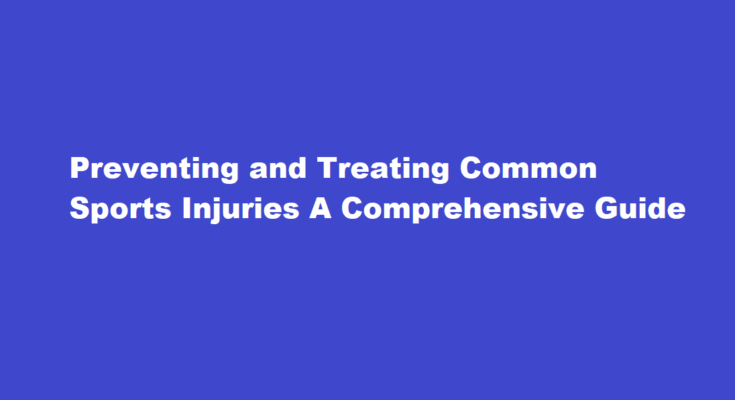Introduction
Engaging in sports and physical activities is not only enjoyable but also essential for maintaining a healthy lifestyle. However, the risk of sustaining sports injuries cannot be ignored. From sprains and strains to fractures and dislocations, sports injuries can occur at any level of athleticism. While some injuries are inevitable, there are proactive measures athletes can take to reduce the risk of injury and promote quicker recovery. In this article, we will explore effective strategies for preventing and treating common sports injuries.
Preventive Measures
1. Warm-up and Stretching
Before starting any physical activity, it is crucial to warm up the body to increase blood flow to the muscles and enhance flexibility. Incorporate dynamic stretches to target specific muscle groups involved in your sport. A proper warm-up prepares the body for the demands of the activity and reduces the risk of strains and sprains.
2. Appropriate Gear and Equipment
Wearing the right gear and equipment is vital in injury prevention. Make sure your equipment, such as helmets, pads, and shoes, is well-fitted and in good condition. The right gear provides support and protection for vulnerable areas, reducing the chances of fractures and head injuries.
3. Gradual Progression
Avoid pushing yourself beyond your physical capabilities too quickly. Gradually increase the intensity, duration, and complexity of your training sessions to allow your body to adapt and build strength progressively. Sudden spikes in activity can lead to overuse injuries or muscle strains.
4. Cross-Training
Incorporate cross-training into your fitness routine. Engaging in a variety of sports and exercises helps in developing a balanced musculoskeletal system and reduces the risk of overuse injuries.
5. Proper Technique and Form
Ensure you learn and apply the correct techniques for your sport or activity. Improper form not only hampers performance but also increases the likelihood of injuries. Seek guidance from coaches or trainers to enhance your skills and reduce the risk of injury.
6. Rest and Recovery
Adequate rest is crucial for allowing the body to heal and repair after intense physical activity. Incorporate rest days into your training schedule and listen to your body’s signals to prevent overtraining and chronic injuries.
Common Sports Injuries and Treatment
1. Sprains and Strains
Sprains involve the stretching or tearing of ligaments, while strains affect muscles or tendons. The RICE method is highly effective for initial treatment: Rest the injured area, Ice the affected area for 15-20 minutes every 2-3 hours, Compress the injury with a bandage to reduce swelling, and Elevate the injured limb to minimize swelling.
2. Fractures
A fracture is a partial or complete break in a bone. Seek medical attention immediately if you suspect a fracture. Immobilize the injured area with a splint or brace and avoid putting weight on it until you receive medical evaluation and treatment.
3. Tendinitis
Tendinitis is the inflammation of a tendon, commonly affecting the shoulders, elbows, or knees. Rest and avoid activities that exacerbate the pain. Applying ice and taking anti-inflammatory medication can help reduce swelling. Physical therapy may be recommended for rehabilitation.
4. Concussions
Concussions are mild traumatic brain injuries resulting from a blow to the head. Any suspected concussion requires immediate medical evaluation. Rest and abstain from sports activities until cleared by a healthcare professional.
5. Shin Splints
Shin splints cause pain along the tibia (shinbone). Rest, ice, and anti-inflammatory medication can alleviate symptoms. Proper footwear and gradual return to physical activity are crucial for prevention and recovery.
6. Dislocations
A dislocation occurs when bones are forced out of their normal positions in a joint. Seek immediate medical attention for reduction and treatment. Afterward, immobilize the joint and follow a rehabilitation plan to regain strength and stability.
FREQUENTLY ASKED QUESTIONS
What is sport injury and its treatment?
Sports injuries are common and can occur throughout your body to bones, muscles, tendons, ligaments and other structures. You can treat many minor injuries at home with rest, ice, compression, elevation and over-the-counter pain medications.
Why is injury prevention important in sports?
Injury prevention should be an important part of every physical activity, because it not only helps you achieve your training goals but also keeps you healthy and safe. Performing complex mathematics without adequate preparation can hurt your brain; running a marathon without adequate preparation can hurt your body.
Conclusion
Sports injuries are a common occurrence but can be minimized with proper preventive measures. Warm-up, appropriate gear, gradual progression, technique, and rest are essential in injury prevention. If an injury does occur, swift and appropriate treatment is crucial for optimal recovery. Remember that seeking professional medical advice is imperative for severe or persistent injuries. By taking proactive steps to prevent injuries and addressing them promptly when they do occur, athletes can continue to enjoy their favorite sports safely and responsibly.
Read Also : Unleashing Creativity Crafting Stunning Digital Art through Graphic Design Software



